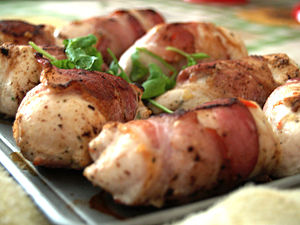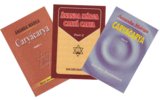Procedure for Eating: Difference between revisions
(→Tamasika Ahara: ++++++) |
(→Meat-eating: More) |
||
| Line 48: | Line 48: | ||
=== Meat-eating === | === Meat-eating === | ||
[[File:Chicken wrapped in prosciutto (335163752).jpg|thumb|Sarkar instructed only those people who will have a strong desire for meat-eating and who need to eat meat out of necessity will eat meat.]] | |||
Only those people who will have a strong desire for meat-eating and who need to eat meat out of necessity will eat meat only from a male or castrated animal. No one should knowingly eat the meat of a female animal. Domestic female fowl should not be eaten as well. | Only those people who will have a strong desire for meat-eating and who need to eat meat out of necessity will eat meat only from a male or castrated animal. No one should knowingly eat the meat of a female animal. Domestic female fowl should not be eaten as well. | ||
Revision as of 05:23, 12 March 2014
Procedure for Eating is the 2nd chapter of Ananda Marga Caryacarya Part 3 written by Prabhat Ranjan Sarkar. The chapter is divided into three parts. In the first part Sarkar instructed the procedure of eating, in the second part he discussed on the types of food and in the third part, he commented on meat-eating.[1]
Prabhat Ranjan Sarkar originally delivered this lecture in Jamalpur at 1956.
Chapter synopsis
This chapter is divided into three parts—
Procedure for Eating
In this chapter Prabhat Ranjan Sarkar instructed the procedure of eating.
Vyapaka shaoca before eating
Sarkar instructed, before eating one should do vyápaka shaoca properly with cold water. If the environment is extremely cold, one may use lukewarm water.
The procedure of this vyapaka shaoca is—
wash the arms, the face, the legs, the neck and the genital organs. Then, keeping the eyes wide open, hold a mouthful of water and gently splash the eyes a minimum of twelve times.
Before sitting down to eat, one should hatever persons are present around you and share your food with them. If they do not want to share, enquire whether they have enough food with them or not.
Eating procedure
While eating one should sit in a comfortable position. It is better to eat in company than to eat alone. One should not sit down to eat in a disturbed mind or angry mood.
Aharya
This is the second part of the chapter and here Sarkar discussed the types of foods. He told, in all object of the universe, one of three attributes – sattva, rajah and tamah – will always be predominant. Similarly the food we eat may be divided into these three categories.
Sattvika Ahara
Sarkar described Sattvika Ahara as "all foods that are beneficial to both body and mind" and provided a list of Sattvika Ahara—
- All the staple food-grains such as rice, wheat, barley, etc.
- All the pulses except masúr (an orange-coloured lentil) and khesári;
- All fruits and roots
- All kinds of vegetables except violet-coloured carrots, white brinjals (white eggplants), onions, garlic and mushrooms;
- Milk and milk products
- All green and leafy vegetables except red puni and mustard.
- All varieties of spices except garam masala
- All kinds of sweets
Sarkar prescribed Sattvika Ahara for avadhútas and avadhútikás of Ananda Marga and the people who are practicing asanas.
Rajasika Ahara
Sarkar told, any food that is beneficial to the body but is neutral to the mind, or vice versa, is called rájasika. Foods that do not fall into the sáttvika or támasika categories are of rájasika nature. In certain countries where there is a heavy snowfall, rájasika food can be treated as sáttvika and támasika food as rájasika.
Tamasika Ahara
Sarkar told, all kinds of foods which are harmful to either the body or mind and may or may not be harmful to the other are called támasika. He also provided few examples of Tamasika Ahara—
- Stale and rotten food
- The flesh of large animals such as cows and buffaloes
- All types of intoxicants
- The milk of a newly-calved cow
- White brinjals
- Khesárii dál
- Green vegetables of the type of red puni or mustard
- Masúr dál cooked for one meal will become támasika by the next meal
Meat-eating
Only those people who will have a strong desire for meat-eating and who need to eat meat out of necessity will eat meat only from a male or castrated animal. No one should knowingly eat the meat of a female animal. Domestic female fowl should not be eaten as well.
Sarkar instructed not to kill a fish which is one-fourth or less of its normal adult size. He also told not to kill a fish if it is in its infancy or its pregnancy.
References
- ^ Prabhat Ranjan Sarkar "Procedure for Eating" The Electronic Edition of the Works of P. R. Sarkar (in English) (7.5 ed.) Ananda Marga Pracaraka Samgha
| Preceded by |
Ananda Marga Caryacarya Part 3 With: Procedure for Eating |
Succeeded by |

